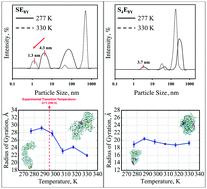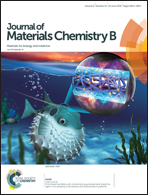Unraveling the molecular mechanisms of thermo-responsive properties of silk-elastin-like proteins by integrating multiscale modeling and experiment†
Abstract
Adaptive hydrogels tailor-made from silk-elastin-like proteins (SELPs) possess excellent biocompatibility and biodegradability with properties that are tunable and responsive to multiple simultaneous external stimuli. To unravel the molecular mechanisms of their physical response to external stimuli in tandem with experiments, here we predict and measure the variation in structural properties as a function of temperature through coarse-grained (CG) modeling of individual and crosslinked SE8Y and S4E8Y molecules, which have ratios of 1 : 8 and 4 : 8 of silk to elastin blocks respectively. Extensive structural reshuffling in single SE8Y molecules led to the increased compactness of the structure, whereas S4E8Y molecules did not experience any significant changes as they already adopted very compact structures at low temperatures. Crosslinking of SE8Y molecules at high concentrations impeded their structural transition at high temperatures that drastically reduced the degree of deswelling through extensive suppression of the structural shuffling and the trapping of the molecules in high potential energy states due to inter-molecular constraints. This integrative experimental and computational understanding of the thermal response in single molecules of SELPs and their crosslinked networks should lead to further improvements in the properties of SELP hydrogels through predictive designs and their wider applications in biomaterials and tissue engineering.



 Please wait while we load your content...
Please wait while we load your content...